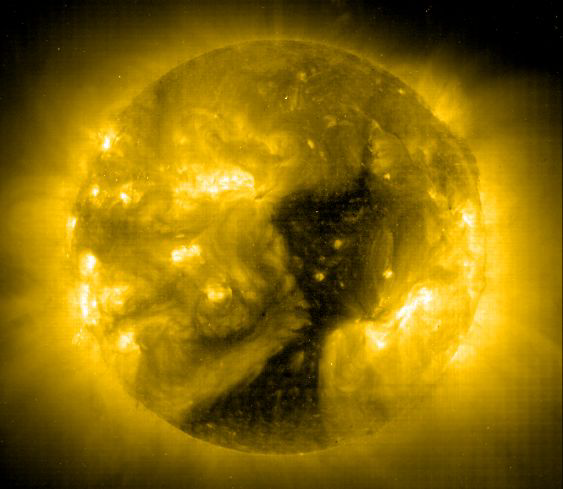What is a Coronal Hole?
Regular readers of the ASWFC Monthly Solar and Geophysical Summary, or those people who receive ASWFC Warning services, have probably seen the term "coronal hole on the Sun" used quite frequently. Not surprising because in the declining phase of solar cycles, coronal holes are the sources of many of the disturbances to the ionosphere (and HF communications) and to the geomagnetic field. But what is a coronal hole and what does one look like?
X-ray images of the Sun often show large dark regions. These are called coronal holes. They may extend from the Sun's equator to its poles, or even in some cases, from pole to pole. Although in the 1960's they were found in X-ray images taken by sounding rockets and detected with the Sydney Chris Cross radio telescope (but not recognised for what they were), they were first seen most clearly in images taken by astronauts on board the Skylab space station in 1973 and 1974.
The solar corona is the outer atmosphere of the Sun, extending from the solar "surface" out into space. It is a region which is difficult to observe, being seen only during solar eclipses or with special equipment. A coronal hole is a large region in the corona which is less dense and is cooler than its surrounds. Such holes may appear at any time of the solar cycle but they are most common during the declining phase of the cycle.
Coronal holes occur when the Sun's magnetic field is open to interplanetary space. Conversely, in regions where the solar magnetic fields loop back to the Sun forming arches, X-ray and UV images show bright areas. The brightest points in the images are generally at the top of the magnetic loops or arches.
The regions of open magnetic field lines are also found to be regions where the corona has a lower density than where the magnetic field lines are closed. The open configuration of the magnetic field in coronal holes allows particles to escape, and it is found that these holes are sources of high speed solar wind streams. When the particles from these streams hit the Earth they may cause geomagnetic storms.
At times of high solar activity, geomagnetic storms are generally the result of Coronal Mass Ejections (CMEs) intersecting the Earth's orbit, but at times of low solar activity, coronal holes are the most common source of geomagnetic storms. Because coronal holes can last for several months, it is often possible to predict the occurrence of this type of geomagnetic disturbance, as the high speed stream sweeps past the Earth with each solar rotation (like a rotating garden sprinkler).
In general, geomagnetic storms originating from coronal holes have a gradual commencement (over hours) and are not as severe as storms caused by CMEs, which usually have a sudden onset.
In the satellite image below the bright regions indicate hotter areas of the solar corona, mainly above the sunspot regions. A large dark region extends from one pole right across the solar equator and well into the other hemisphere. It is from coronal holes like this one that ASWFC makes forecasts of disturbances to HF communications and other Earth and space-based technology.

Although coronal holes are best observed in extreme ultraviolet or X-ray images, they can also be observed from the ground in the light of helium at a wavelength of 1083 nanometres.
Material prepared by John Kennewell and Andrew McDonald






